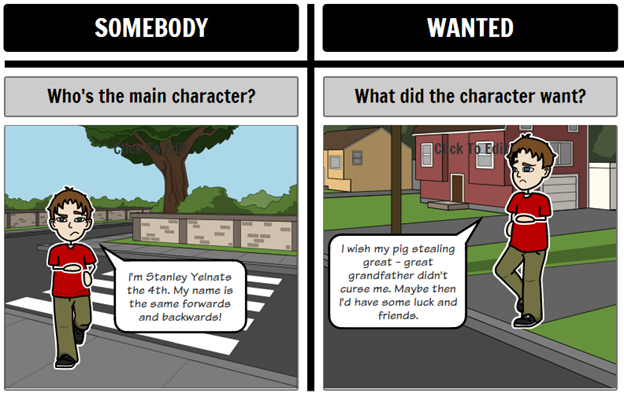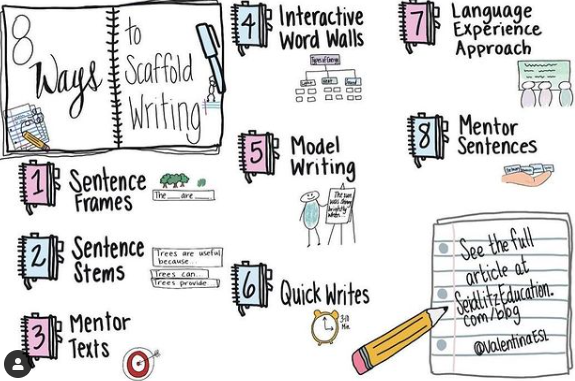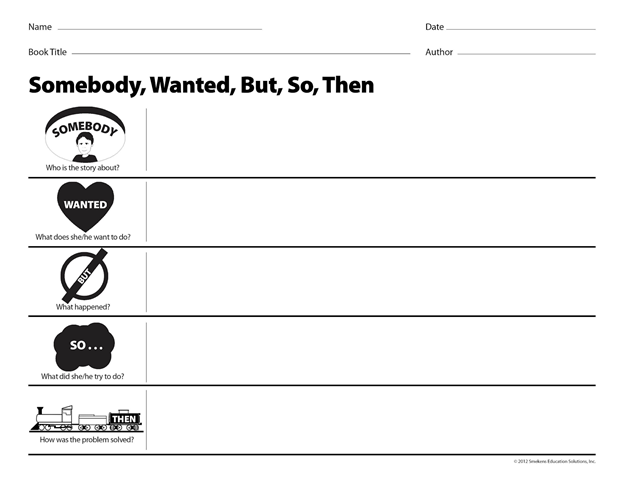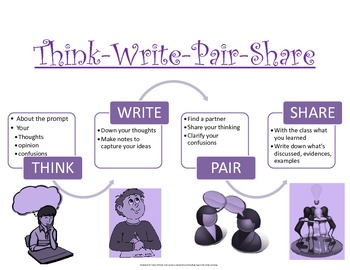@ell_lady
Can you picture it? You look in your curriculum map and notice the culminating task for your students is to write a summary. You panic a little inside and may ask yourself, “How am I going to get them from point A to Z!?”
One of the best ways to get there is to do tiny steps and get students writing routinely so that the culminating task doesn’t seem so daunting. Where should you start? Before you panic, just remember that “Somebody Wanted But So Then” is here to help.
The Somebody Wanted But So Then strategy, or SWBST, is a quick and easy way to get students to write a summary and can be done with just about any text. I like to use it with my newcomer ESL students by just shortening it a little to a SWB or SWBS. After practicing this strategy with a graphic organizer, students get used to doing it and can write their own sentences without it quickly. I like using StoryboardThat for this. Let’s look at the steps we can take to get students started with this strategy and how we can get them to where we want them to be- writing a summary on their own!
Start with a Write-Aloud
Modeling is a great way to begin and this can just be done on a whiteboard whether virtually or in-person- anything you can write on and let students clearly see it will work. Students are probably also feeling a little overwhelmed, and they are looking to you, dear teacher! So show them the way!
During a write-aloud, the teacher says out loud what their thought process is for their writing. They go step-by-step and give opportunities for students to demonstrate that they are following and comprehending. Some ways might be having students repeat after you or choral read what you have just written.
While you are making sure that your students are following along, it’s also important to check for understanding and allow students to digest your write-aloud by discussing it with their classmates. In addition, it’s a great time to point out any grammar or vocabulary you want to focus on. Here’s an example conversation:
Teacher: I am going to do a write-aloud for a summary about the text we just read. I am going to use the structure- Somebody Wanted But So Then. Ok, who is this text about? Hmm…I know it’s about a character named Romeo and the girl he likes, Juliet. So, I am going to start with this: Romeo and Juliet wanted…Let’s repeat that together! (Choral read: Romeo and Juliet wanted…)
Teacher: Well, what did they want? Let’s turn and talk and discuss that with these sentence stems: I think Romeo and Juliet wanted…do you agree?
Once ideas are thought out and students agree, the teacher can bring students back to whole group and finish the ideas students have with their sentences. This process is focused on the teacher’s ideas, but as you can see, students are involved in the process as well. This is a great way to manage our teacher talk.
Shared Writing
After modeling writing for your students, you can now write together. Let’s go back to our Romeo and Juliet example. Let’s say we are also reviewing the scene where they first meet at the party. Before writing, I may get students to discuss what happened first in a think-pair-share. After students have their ideas, I’ll ask them to share-out some of them with accountable talk frames like, “My partner and I agreed that in this scene…”
Now, I’m going to ask them how I should start the sentence. I might say, “Okay Jose, what word are we going to start with for our SWBST (Somebody Wanted But So Then)? What did they want? While we are writing this together, I’m also pointing out that we may want to use a comma to separate the sentence and I’m also noting where to add capital letters and a period.
What are students doing during this shared writing? They are writing with you! On page 96 of Valentina Gonzalez and Melinda Miller’s book, Reading and Writing with English Learners, they recommend giving each student a small dry erase board to practice writing the sentence parts with you. This also ensures all students are engaged. In their book, you can see more about this writing process going from modeling all the way to independent work.

Independent Writing
Up until this point, students have engaged in writing through teacher’s modeling, through discussions with a partner, whole group discussion around what may come next in a sentence, and practiced writing on their own. Now, it’s time to try writing without modeling and sharing, but how can we still support our students as they do their “you do” portion of the lesson?
By providing scaffolds to help them construct their sentences. Scaffolds may look like a graphic organizer or writing template, student-constructed visuals such as drawings or photos entered from a Google search, adding a word bank, using a translator, providing a student work sample for them, or providing sentence frames and stems. These scaffolds should be considered when thinking about a student’s language level if they are an Emergent Bilingual, or English Learner.
In addition to scaffolds, teachers should be monitoring how students are doing and assisting them through questioning and probing for ideas.
Make it a routine
Writing Wednesdays, anyone? As we said earlier, making it a routine in your classroom is the key to less overwhelm and more practice for the big thing, whether it’s a culminating task or a state or federal assessment (here’s looking at you, WIDA for our ESL students). Let’s end this with some easy everyday writing tasks for you to get going.
Easy ways to start writing routinely in class:
- Quickwrites
- Interview and write
- Think, Write, Pair, Share
- ACES- Answer – Cite – Explain writing strategy
References
Reading & Writing with English Learners: a Framework for K-5, by Valentina
Gonzalez and Melinda Miller, Seidlitz Education, 2020, pp. 96.







